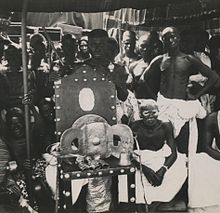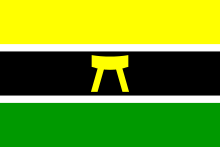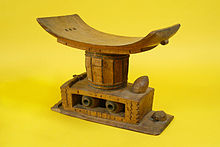Yaa Asantewaa I was the Queen Mother of Ejisu in the Ashanti Empire, now part of modern-day Ghana. She was appointed by her brother Nana Akwasi Afrane Okese, the Edwesuhene, or ruler, of Edwesu. In 1900, she led the Ashanti war also known as the War of the Golden Stool, or the Yaa Asantewaa War of Independence, against the British Empire.
Osei Kofi Tutu I was one of the founders of the Ashanti Empire, assisted by Okomfo Anokye, his chief priest and a distant relative from the town of Awukugua–Akuapem. The Asante comes from the Akan ethnic group of West Africa. Osei Tutu I led an alliance of Asante states against the regional hegemony, the Denkyira, completely defeating them. He ruled the Kwaman State between c.1680/c.1695 and 1701 and he ruled the Ashanti Empire from late 1701 to around 1717.

Osei Tutu II is the 16th Asantehene, enstooled on 26 April 1999. By name, Otumfuo Osei Tutu II is in direct succession to the 17th-century founder of the Ashanti Empire, Otumfuo Osei Tutu I. He is also the Chancellor of the Kwame Nkrumah University of Science and Technology. A Freemason, Otumfuo Osei Tutu II has served as the Grand Patron of the Grand Lodge of Ghana, the Sword Bearer of the United Grand Lodge of England and the Grand Patron of the Grand Lodge of Liberia.

The Asante Empire, also known as the Ashanti Empire, was an Akan state that lasted from 1701 to 1901, in what is now modern-day Ghana. It expanded from the Ashanti Region to include most of Ghana and also parts of Ivory Coast and Togo. Due to the empire's military prowess, wealth, architecture, sophisticated hierarchy and culture, the Asante Empire has been extensively studied and has more historic records written by European, primarily British, authors than any other indigenous culture of sub-Saharan Africa.
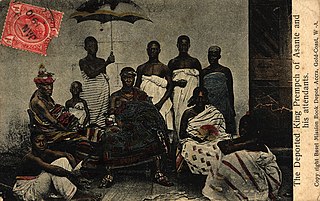
Prempeh I was the thirteenth king ruler of the Ashanti Empire and the Oyoko Abohyen Dynasty. King Prempeh I ruled from March 26, 1888 until his death in 1931, and fought an Ashanti war against Britain in 1895-6.

Otumfuo Opoku Ware II was the 15th Asantehene. He succeeded his uncle Osei Tutu Agyeman Prempeh II on 27 July 1970. He ruled for 29 years until his death in February 1999. He was succeeded by Otumfuo Nana Osei Tutu II.

The Asante, also known as Ashanti in English, are part of the Akan ethnic group and are native to the Ashanti Region of modern-day Ghana. Asantes are the last group to emerge out of the various Akan civilisations. Twi is spoken by over nine million Asante people as their native language.

The Manhyia Palace is the seat of the Asantehene, as well as his official residence. It is located in Menshyia, Kumasi, the capital of the Ashanti Region of Ghana. The first palace is now a museum. Otumfuor Opoku Ware II built the new palace, which is close to the old one and is where the current Asantehene, Otumfuor Osei Tutu II, resides.
Juaben is a small town in the Ejisu-Juaben Municipal District, a district in the Ashanti Region of Ghana.
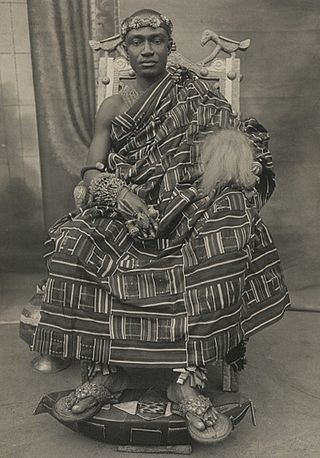
Prempeh II, was the 14th Asantehene, or king of the Ashanti, reigning from 22 June 1931 to 27 May 1970.

An Akrafena is an Akan sword, originally meant for warfare but also forming part of Akan heraldry. The foremost example of an akrafena is the Mponponsuo, which belonged to Opoku Ware II. It has survived to the present day because it is still occasionally used in ceremonies, such as the Akwasidae Festival.

The Ashanti flag is the flag of the Ashanti people. It depicts the Golden Stool, the throne of the Asantehene.
Nana Afia Kobi Serwaa Ampem II was the Queen mother (Ohemaa) of the Ashanti Kingdom and mother of the current Asantehene, Otumfuo Nana Osei Tutu II, who is the youngest son of her five children. She was the 13th Queen mother of the Ashanti Kingdom.
Osei Bonsu was a Ghanaian sculptor and practitioner of Ashanti carving.
Nana Obiri Yeboa was the Kumasehene during his era and the occupant of the Aban Dwa Stool. He reigned from 1660 to 1680. He was succeeded by Nana Osei Tutu as the chief of Kwaman state which was later known as Kumasi state. He was the uncle of Osei Tutu. Nana Obiri Yeboa's uncle was Nana Oti Akenten.
The political organization of the historical Asante Empire was characterized by stools which denoted "offices" that were associated with a particular authority. The Golden Stool was the most powerful of all, because it was the office of the King of the Asante Empire. Scholars such as Jan Vansina have described the governance of the Asante Empire as a federation where state affairs were regulated by a council of elders headed by the king, who was simply primus inter pares.

Konadu Yaadom, also Kwadu Yaadom was the fourth Asantehemaa of the Ashanti Empire, whose multiple marriages and spiritual influence meant that she became an important and powerful ruler in the eighteenth and early nineteenth centuries.

Oheneba is a regal rank given to both female or male child of a king or chief. It is the equivalent of prince or princess.
The Asantehemaa is the queen mother according to West African custom, who rules the Asante people alongside the Asantehene. African queen mothers generally play an important role in local government; they exercise both political and social power. Their power and influence have declined considerably since pre-colonial times, but still persist in the 21st century.
